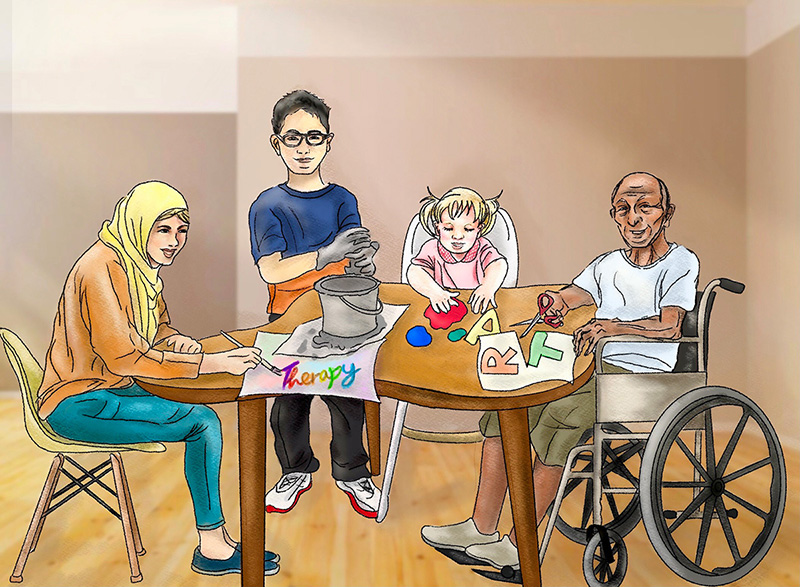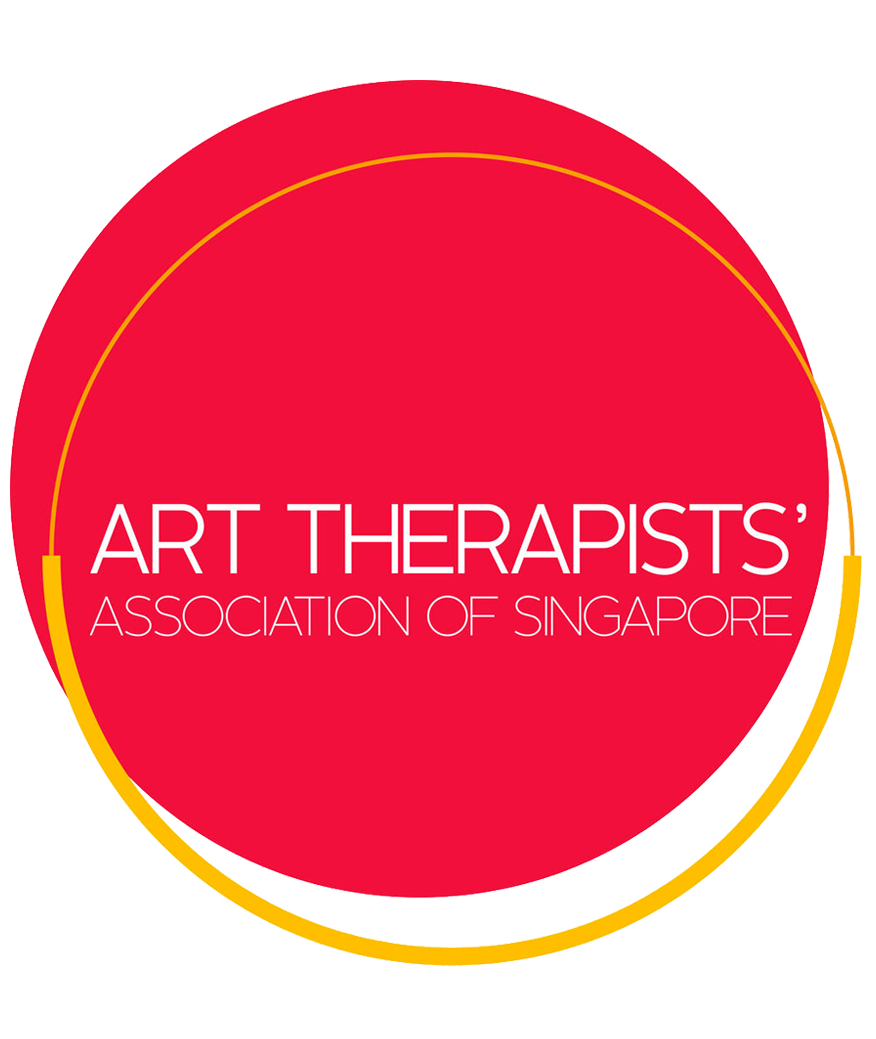
Therapy
Becoming an Art Therapist
Art therapists are mental health and human services professionals who have completed a master’s degree in art therapy with supervised clinical practicum following which they can pursue further credentialing and national licensure. Practising art therapists undertake continuing professional development to ensure competency and expand repertoire of knowledge.
Honouring every individual, art therapists are committed to practise as competent, culturally sensitive, and ethical clinicians.
PRACTICING IN SINGAPORE
Art therapists practicing in Singapore must have a Masters in Art Therapy to practice and are encouraged to be members of the Art Therapists’ Association Singapore and to be credentialed with a credentialing body such as The Australian, New Zealand and Asian Creative Arts Therapy Association (ANZACATA).
FAQ ON BECOMING AN ART THERAPIST
Interested to become an art therapist? Here are some of the most frequent questions we receive:
1. What qualifications and education do I need?
In order to practice ethically and legally as an art therapist, it is mandatory to have a master’s degree in art therapy from an approved and accredited art therapy programme.
2. How do I select a Master’s programme? Where can I find a list of Master's Art Therapy programmes?
This decision may depend on where you would like to practice as an art therapist upon graduation.
In Singapore, the MA Art Therapy Programme at LASALLE is a two-year, four semester full-time training programme spanning a range of psychotherapeutic concepts, theories and practices. It is the first of its kind to be developed and implemented in Southeast Asia. The programme is formally approved by the
Australian, New Zealand and Asian Creative Arts Therapy Association (ANZACATA). Graduates are eligible to apply for professional registration (AThR) with ANZACATA. It may be possible to apply for professional membership with other international art therapy organisations and registration authorities.

Beyond Singapore, you may find some approved and accredited art therapy programmes by some of the following international art therapy associations:



3. What are the career opportunities?
Art therapists work across a broad range of settings including private and public institutions and organizations. For more details, click here
4. Do I need to be an artist or expert in art to be an art therapist?
A first degree in fine art, visual arts or design is advantageous. However, graduates with experience in health, education or social care may be considered if they demonstrate commitment to the practice of the visual arts. Relevant undergraduate degrees include:
- education/teaching
- nursing
- occupational therapy
- psychology
- social work
Some programmes may also accept graduates with degrees in the humanities, social sciences or sciences or individuals with prior experience of working in community arts projects.
5. How do I know if I am suited to be an art therapist?
If you have an interest and commitment to the visual arts within the context of helping others achieve mental wellness, you may be suited to be an art therapist. Some of the skills that art therapists require are : a keen sense of observation and active listening skills; empathic communication and the ability to create a safe holding environment for their clients.
Often, art therapists are self-starters; they are involved in setting up new art therapy programmes, sharing knowledge and advocating the healing nature of arts in therapy. Some art therapists begin their career in self-employment and private practice, which requires strong entrepreneurial and administrative skills.
Many art therapists work in multidisciplinary teams and collaborate and engage in partnership with other professionals such as artists-in-health to develop innovative approaches to practice.
Art therapists engage in their own art-making as a means of self-exploration and expression. They also engage in reflexive practice to work towards greater self-knowledge and growth.
If you are still unsure about embarking in this profession, looking into introductory short courses in art therapy may be a good idea. Engaging in your own personal therapy with an art therapist might also inform your understanding and decision of pursuing the profession.
#2
About Art Therapy
WHAT IS ART THERAPY?
BENEFITS OF ART THERAPY / HOW CAN ART THERAPY HELP?
HOW DOES IT WORK?
Art therapy is an integrative psychotherapeutic intervention that promotes mental well-being through the creative process within a therapeutic relationship. Art therapy is facilitated by professional art therapists who hold at minimum a master’s degree in art therapy.
Art therapy focuses on the psychological and emotional well-being and development of individuals who stand to benefit in the following ways:
- Improved behavioural and emotional regulation
- Increased hope, motivation and empowerment
- Insight into and resolution of inner conflicts
- Enhanced emotional and psychological resilience
- Increased self-awareness and self-confidence
- A positive sense of self and self-identity
- Improved relationships and social skills
- Enhanced problem solving and coping skills
The process of engaging in visual expression through a multi-sensory experience offers a form of self-expression that can be cathartic, revealing, and meaningful. Art therapy is non-confrontational as the art work acts as a buffer for content that may be difficult to verbalise. Visual expression allows the emergence and re-contextualisation of difficult experiences and emotions, facilitating a clearer understanding and path to resolution and healing.
Art therapy is an empirically validated intervention. Ongoing research on art therapy and advancement in neuroscience has demonstrated neural pathways and activations of different parts of the brain that are involved in processing visual, somatosensory, emotional, motor, and memory-related information.
Practitioners and researchers, from different parts of the world, continue to explore and publish studies on art therapy with diverse populations and settings.
The American Art Therapy Association Research Committee has collated a list of art therapy outcomes and single-case studies to support the practice and development of art therapy globally.
To gain knowledge and greater insights into the therapeutic effect of art therapy, ATAS would like to cordially invite art therapists to support the art therapy community by sharing your research papers with our members.
Inaccurate use of term Art Therapy
Inaccurate use of “art therapy” often occurs due to a lack of knowledge about the profession. Such instances provide an opportunity to offer accurate information and educate the public. It is with this in mind that the ATAS encourages outreach to individuals and/or companies that may be found to inaccurately categorize activities (such as trainings that are offered by non-art therapists) or products (such as adult coloring books) as “art therapy.
Additional inquiries can be directed to the ATAS at contact@atas.org.sg.
ADDRESSING CONCERNS ABOUT REPRESENTATION OR SERVICES
If you encounter an individual who may be erroneously identifying himself/herself as an art therapist, please review “How to Proceed When You Believe Someone is Misrepresenting Him/Herself as an Art Therapist.”
Professional credentials in art therapy can be verified through the Art Therapy Credentials Board.
#3
Who can benefit?

Credit: Yau Gee Lam
Art therapy has been found to benefit people through the human lifespan. Art therapists work with individuals with medical and mental health challenges, as well as individuals who are seeking emotional, creative, and spiritual growth. Art therapy has broad application across diverse cultures and is not reserved for any single diagnosis or situation.
Art therapy may stand alone, prompting change as a primary therapeutic intervention; it can also complement, provide stability and continuity within other treatments. To this end, art therapists remain versatile and responsive to working alongside other professionals within a multidisciplinary team.
An array of research studies have demonstrated the efficacy of art therapy with various client populations in areas such as:
- Developmental and learning difficulties (e.g. autism spectrum disorder)
- Loss and bereavement (e.g. illness, relocation, divorce, loss of employment)
- Palliative care, chronic illness
- Eating disorder and issues with body image, addiction, psychosomatic illness
- Mental health needs (e.g. depression, schizophrenia, addictions, trauma, psychosis, anxiety, BPD)
#4
Where are Art Therapists located?
Art therapists work with individuals, couples, families, elderly, and groups and practice in a variety of settings in Singapore such as:
- Schools (both mainstream and special needs)
- Acute and community hospitals
- Home & hospice care
- Family services centers
- Forensic institution
- Mental health institutions
- Community and private clinics
- Senior communities
- Crisis centers
If you would like to locate professionally qualified art therapists in Singapore,
please proceed to our ‘Therapist Directory’ where you can find art therapists by specialization/interest, qualifications/credentials and work location.
